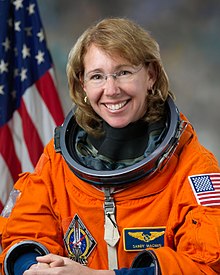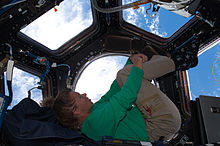Sandra Magnus
Sandra Magnus | |
|---|---|
 | |
| Born | October 30, 1964 |
| Status | Retired |
| Nationality | American |
| Occupation | Executive Director American Institute of Aeronautics and Astronautics Engineer |
| Space career | |
| NASA Astronaut | |
Time in space | 157d 08h 42m[1] |
| Selection | 1996 NASA Group |
| Missions | STS-112, STS-126, Expedition 18, STS-119, STS-135 |
Mission insignia | |
Sandra Hall Magnus (born October 30, 1964) is an American engineer and a NASA astronaut.[2] She returned to Earth with the crew of STS-119 Discovery on March 28, 2009, after having spent 134 days in orbit.[3] She was assigned to the crew of STS-135, the final mission of the Space Shuttle. She is also a licensed amateur radio operator with the call sign KE5FYE.
Biography
Early life and education
Magnus was born and raised in Belleville, Illinois. She earned degrees in physics and electrical engineering from the University of Missouri–Rolla (now known as the Missouri University of Science and Technology) before earning a PhD in materials science and engineering from the Georgia Institute of Technology in 1996. Research for her dissertation, entitled "An Investigation of the relationship between the thermochemistry and emission behavior of thermionic cathodes based on the BaO-Sc2O3-WO3 ternary system," was supported by a fellowship from the NASA Lewis Research Center.[4][2]
Engineering career
During the 1980s, Magnus worked on stealth aircraft design as an engineer for McDonnell Douglas. She worked on the propulsion system for the A-12 Avenger II until the project was canceled by the Navy in 1991.[2]
NASA career

STS-112
Magnus was selected as an astronaut candidate in 1996 and flew her first space mission, STS-112, in October 2002 as a mission specialist. The main objective of Space Shuttle Atlantis' mission was the installation of the S1 truss section on the International Space Station (ISS) and consumables delivery. Magnus operated the space station's robotic arm during the three spacewalks required to install and activate the S1 truss. The flight duration was 10 days 19 hours 58 minutes and 44 seconds.
Survival training
From January 29–31, 2006, together with Oleg Artemiev and Michael Barratt, Magnus took part in a two-day examination for the ability to survive in an uninhabited area in case of the Soyuz descent module making an emergency landing. She passed this examination in the forest near Moscow.[5]
NEEMO 11
From September 16–22, 2006, Magnus served as the commander of NASA's NEEMO 11 mission, an undersea expedition at the National Oceanic and Atmospheric Administration's Aquarius laboratory located off the coast of Florida. With fellow astronaut/aquanauts Timothy Kopra, Robert Behnken and Timothy Creamer, all of whom were training for possible assignment to missions to the International Space Station, Magnus imitated moonwalks, tested concepts for mobility using various spacesuit configurations and weights to simulate lunar gravity. Techniques for communication, navigation, geological sample retrieval, construction and using remote-controlled robots on the moon's surface also were tested. National Undersea Research Center support crew members Larry Ward and Roger Garcia provided engineering support inside the habitat.[6]
Expedition 18
Magnus served as Flight Engineer on board the International Space Station as part of Expedition 18.[2] Magnus was a Mission Specialist on STS-126 for the trip to the station, which launched on November 14, 2008.[7] She served as Mission Specialist on STS-119 when it returned on March 28, 2009.[2][8] She logged 133 days in orbit and received warm greetings from NASA on her return. Her replacement, JAXA astronaut Koichi Wakata, was launched aboard Discovery on March 15, 2009.[3]
STS-135

On September 14, 2010, NASA announced Magnus to be one of four astronauts assigned to the STS-135 "launch on need" crew that was, if needed, to fly a rescue mission for STS-134, which was originally the last scheduled shuttle flight.[9] Other members assigned to that crew were commander Christopher Ferguson, pilot Douglas G. Hurley, and fellow mission specialist Rex J. Walheim. In January 2011, NASA added STS-135 to the manifest as the final space shuttle mission, scheduled to launch in July 2011; STS-134 was conducted successfully in May 2011, requiring no rescue flight. The mission launched successfully on 8 July 2011 and landed on July 21.
AIAA
Dr. Magnus left NASA Astronaut corps to become the Executive Director of the American Institute of Aeronautics and Astronautics (AIAA) .[10]
References
![]() This article incorporates public domain material from websites or documents of the National Aeronautics and Space Administration.
This article incorporates public domain material from websites or documents of the National Aeronautics and Space Administration.
- ^ Astronauts and Cosmonauts (sorted by "Time in Space")
- ^ a b c d e "Sandra H. Magnus (Ph.D.) NASA Astronaut". Lyndon B. Johnson Space Center. NASA. June 2008. Retrieved 2008-11-16.
- ^ a b "Shuttle lands in Florida, ending 13-day voyage". AP. 2009-03-28. Retrieved 2009-03-28.
- ^ Magnus, Sandra (May 1996). "An Investigation of the relationship between the thermochemistry and emission behavior of thermionic cathodes based on the BaO-Sc2O3-WO3 ternary system". SMARTech. Georgia Institute of Technology. Retrieved 2008-11-16.
- ^ "Future cosmonauts learn to survive in freezing weather in the Moscow forests". RuSpace. January 27, 2006. Retrieved April 30, 2011.
- ^ NASA (May 11, 2010). "NASA - NEEMO 11". NASA. Retrieved September 26, 2011.
- ^ "NASA's Shuttle and Rocket Missions". NASA. 2008-11-14. Retrieved 2008-11-16.
- ^ "Cleared for Takeoff: Georgia Tech Graduate is Crewmember on Shuttle Mission to ISS". News Room. Georgia Institute of Technology. 2002-08-06. Retrieved 2008-11-14.
- ^ NASA (September 14, 2010). "NASA Assigns Crew for Final Launch on Need Shuttle Mission". Retrieved September 14, 2010.
- ^ "AIAA Announces Sandra H. Magnus as Executive Director". September 19, 2012.
External links
- 1964 births
- Living people
- Amateur radio people
- American astronauts
- Aquanauts
- Crew members of the International Space Station
- Women astronauts
- Georgia Institute of Technology alumni
- Missouri University of Science and Technology alumni
- People from Belleville, Illinois
- Women in engineering
- Women in technology
- Amateur radio women
